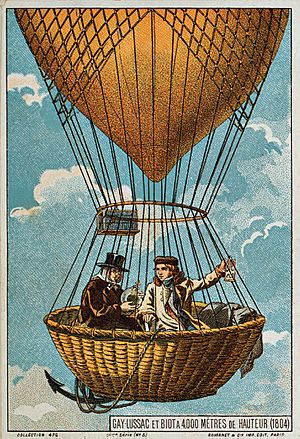Joseph Louis Gay-Lussac facts for kids
Quick facts for kids
Joseph Louis Gay-Lussac
|
|
|---|---|

Joseph Louis Gay-Lussac
|
|
| Born | 1778 Saint-Léonard-de-Noblat, Kingdom of France
|
| Died | 9 May 1850 (aged 71) |
| Nationality | French |
| Alma mater | École polytechnique |
| Known for | Gay-Lussac's law |
| Scientific career | |
| Fields | Chemistry |
| Signature | |
 |
|
Joseph Louis Gay-Lussac (born December 6, 1778 – died May 9, 1850) was a famous French chemist and physicist. He is best known for discovering that water is made of two parts hydrogen and one part oxygen, which he did with Alexander von Humboldt. He also created two important laws about gases. His work on alcohol and water mixtures led to the "degrees Gay-Lussac" scale, which is still used today to measure how much alcohol is in drinks in many countries.
Contents
Joseph Louis Gay-Lussac's Life Story
Gay-Lussac was born in Saint-Léonard-de-Noblat, a town in France. His father was a lawyer and judge. The family later added "Lussac" to their name, becoming Gay-Lussac.
He started his education with the Catholic Abbey of Bourdeix. Later, he moved to Paris to continue his studies. In 1798, he entered the École Polytechnique, a famous science school. His father was in prison during this time because of the French Revolution.
After three years, Gay-Lussac moved to the École Nationale des Ponts et Chaussées. Soon after, he became an assistant to Claude Louis Berthollet, another important scientist.
In 1802, he became a demonstrator at the École Polytechnique. By 1809, he was a professor of chemistry there. From 1808 to 1832, he also taught physics at the Sorbonne. He later became a chemistry professor at the Jardin des Plantes.
Gay-Lussac was recognized by many scientific groups. He became a foreign member of the Royal Swedish Academy of Sciences in 1821. In 1832, he was elected an Honorary Member of the American Academy of Arts and Sciences. He also served in the French government, representing Haute-Vienne in the chamber of deputies and later joining the chamber of peers.
In 1809, Gay-Lussac married Geneviève-Marie-Joseph Rojot. He first met her when she was working in a shop and secretly studying a chemistry book. They had five children. His eldest son, Jules, also became a scientist. Sometimes, their work can be confused because they both used "J. Gay-Lussac" for their publications.
Joseph Louis Gay-Lussac died in Paris in 1850. He is buried in the Père Lachaise Cemetery. His name is one of the 72 names written on the Eiffel Tower.
Amazing Discoveries and Achievements
- 1802 – Gay-Lussac's Law: He was the first to clearly state a law about gases. This law says that if you keep the amount and space of a gas the same, its pressure goes up as its temperature rises. This is sometimes written as p = k T, where p is pressure, T is temperature, and k is a constant number.
- 1804 – Hot Air Balloon Flight: He and Jean-Baptiste Biot went up in a hot-air balloon to a height of about 7,016 meters (23,018 feet). They did this to study the Earth's atmosphere. He wanted to collect air samples at different heights to see how temperature and moisture changed.
- 1805 – Water Composition: With his friend Alexander von Humboldt, he found that the air's makeup doesn't change much as you go higher. They also discovered that water is made of two parts hydrogen and one part oxygen by volume.
- 1808 – Discovering Boron: He helped discover the element boron.
- 1810 – Chemical Analysis: Working with Louis Thenard, he created a way to measure the elements in a substance. He also wrote down the equation for how alcohol is made through fermentation.
- 1811 – Identifying Iodine: He realized that iodine was a new element. He described its features and suggested the name iode.
- 1815 – Creating Cyanogen: He made cyanogen, figured out its chemical formula, and gave it its name.
- 1824 – Lab Tools: He improved the burette, a tool used in chemistry labs. He also came up with the names "pipette" and "burette" in a paper he wrote that year.
- Honors: In Paris, a street and a hotel near the Sorbonne are named after him. There is also a square and a street named after him in his hometown, Saint-Léonard-de-Noblat.
Images for kids
See also
 In Spanish: Louis Joseph Gay-Lussac para niños
In Spanish: Louis Joseph Gay-Lussac para niños



